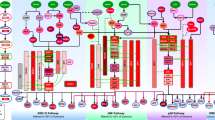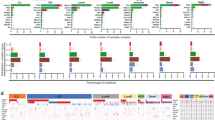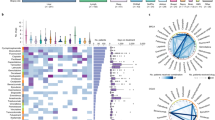Abstract
The accumulation of multiple mutations and alterations in the cancer genome underlies the complexity of cancer phenotypes. A consequence of these alterations is the deregulation of various cell-signalling pathways that control cell function. Molecular-profiling studies, particularly DNA microarray analyses, have the potential to describe this complexity. These studies also provide an opportunity to link pathway deregulation with potential therapeutic strategies. This approach, when coupled with other methods for identifying pathway activation, provides an opportunity to both match individual patients with the most appropriate therapeutic strategy and identify potential options for combination therapy.
This is a preview of subscription content, access via your institution
Access options
Subscribe to this journal
Receive 12 print issues and online access
$209.00 per year
only $17.42 per issue
Buy this article
- Purchase on Springer Link
- Instant access to full article PDF
Prices may be subject to local taxes which are calculated during checkout




Similar content being viewed by others
References
Ramaswamy, S. & Golub, T. R. DNA microarrays in clinical oncology. J. Clin. Oncol. 20, 1932–1941 (2002).
Golub, T. R. Genome-wide views of cancer. N. Engl. J. Med. 3, 601–602 (2001).
Golub, T. R. et al. Molecular classification of cancer: class discovery and class prediction by gene expression monitoring. Science 286, 531–537 (1999).
Alizadeh, A. A. et al. Distinct types of diffuse large B-cell lymphoma identified by gene expression profiling. Nature 403, 503–511 (2000).
Rosenwald, A. et al. The use of molecular profiling to predict survival after chemotherapy for diffuse large-B-cell lymphoma. N. Engl. J. Med. 346, 1937–1947 (2006).
Perou, C. M. et al. Molecular portraits of human breast tumors. Nature 406, 747–752 (2000).
Sorlie, T. et al. Gene expression patterns of breast carcinomas distinguish tumor subclasses with clinical implications. Proc. Natl. Acad. Sci. USA 98, 10869–10874 (2001).
van'T Veer, L. J. et al. Gene expression profiling predicts clinical outcome of breast cancer. Nature 415, 530–536 (2002).
van de Vijver, M. J. et al. A gene-expression signature as a predictor of survival in breast cancer. N. Engl. J. Med. 347, 1999–2009 (2002).
Paik, S. et al. A multigene assay to predict recurrence of tamoxifen-treated, node-negative breast cancer. N. Engl. J. Med. 351, 2817–2826 (2004).
Pittman, J. et al. Integrated modeling of clinical and gene expression information for personalized prediction of disease outcomes. Proc. Natl. Acad. Sci. USA 101, 8431–8436 (2004).
Huang, E. et al. Gene expression predictors of breast cancer outcomes. Lancet 361, 1590–1596 (2003).
Dave, S. S. et al. Molecular diagnosis of Burkitt's lymphoma. N. Engl. J. Med. 354, 2431–2442 (2006).
Dave, S. S. et al. Prediction of survival in follicular lymphoma based on molecular features of tumor-infiltrating immune cells. N. Engl. J. Med. 351, 2159–2169 (2004).
Rhodes, D. R. et al. Mining for regulatory programs in the cancer transcriptome. Nature Genet. 37, 579–583 (2005).
Rhodes, D. R. et al. Large-scale meta-analysis of cancer microarray data identifies common transcriptional profiles of neoplastic transformation and progression. Proc. Natl. Acad. Sci. USA 101, 9309–9314 (2004).
Dahlquist, K. D., Salomonis, N., Vranizan, K., Lawlor, S. C. & Conklin, B. R. GenMAPP, a new tool for viewing and analyzing microarray data on biological pathways. 31, 19–20 (2002).
Al-Shahrour, F., Diaz-Uriarte, R. & Dopazo, J. FatiGO: a web tool for finding significant associations of Gene Ontology terms with groups of genes. Bioinformatics 20, 578–580 (2004).
Huang, E. et al. Gene expression phenotypic models that predict the activity of oncogenic pathways. Nature Genet. 34, 226–230 (2003).
Black, E. P. et al. Distinct gene expression phenotypes of cells lacking Rb and Rb family members. Cancer Res. 63, 3716–3723 (2003).
Bild, A. et al. Oncogenic pathway signatures in human cancers as a guide to targeted therapies. Nature 439, 353–357 (2006).
Sweet-Cordero, A. et al. An oncogenic KRAS2 expression signature identified by cross-species gene expression analysis. Nature Genet. 37, 48–54 (2005).
Adler, A. S. et al. Genetic regulators of large-scale transcriptional signatures in cancer. Nature Genet. 38, 421–430 (2006).
Zuber, J. et al. A genome-wide survey of RAS transformation targets. Nature Genet. 24, 144–152 (2000).
Tchernitsa, O. I. et al. Gene expression profiling of fibroblasts resistant toward oncogene-mediated transformation reveals preferential transcription of negative growth regulators. Oncogene 18, 5448–5454 (1999).
Vasseur, S. et al. Gene expression profiling by DNA microarray analysis in mouse embryonic fibroblasts transformed by rasV12 mutated protein and the E1A oncogene. Mol. Cancer 2, 19 (2003).
Lamb, J. et al. A mechanism of cyclin D1 action encoded in the patterns of gene expression in human cancer. Cell 114, 323–334 (2003).
Desai, K. V. et al. Initiating oncogenic event determines gene-expression patterns of human breast cancer models. Proc. Natl. Acad. Sci. USA 99, 6967–6972 (2002).
Segal, E., Friedman, N., Kaminski, N., Regev, A. & Koller, D. From signatures to models: understanding cancer using microarrays. Nature Genet. 37 (Suppl.), S38–S45 (2005).
Segal, E., Friedman, N., Koller, D. & Regev, A. A module map showing conditional activity of expression modules in cancer. Nature Genet. 36, 1090–1098 (2004).
Segal, E. et al. Module networks: identifying regulatory modules and their condition-specific regulators from gene expression data. Nature Genet. 34, 66–176 (2003).
Stuart, J. M., Segal, E., Koller, D. & Kim, S. K. A gene-coexpression network for global discovery of conserved genetic modules. Science 302, 249–255 (2003).
Segal, E., Wang, H. & Koller, D. Discovering molecular pathways from protein interaction and gene expression data. Bioinformatics 19 (Suppl. 1), i264–i271 (2003).
Subramanian, A. et al. Gene set enrichment analysis: a knowledge-based approach for interpreting genome-wide expression profiles. Proc. Natl. Acad. Sci. USA 102, 15545–15550 (2005).
Barry, W. T., Nobel, A. B. & Wright, F. A. Significance analysis of functional categories in gene expression studies: a structure permutation approach. Bioinformatics 21, 1943–1949 (2005).
Tian, L. et al. Discovering statistically significant pathways in expression profiling studies. Proc. Natl. Acad. Sci. USA 102, 13544–13549 (2005).
Edelman, E. et al. Analysis of sample set enrichment scores: assaying the enrichment of sets of genes for individual samples in genome-wide expression profiles. Bioinformatics (in the press).
Alvarez, J. V. et al. Identification of a genetic signature of activated signal transducer and activator of transcription 3 in human tumors. Cancer Res. 65, 5054–5062 (2005).
Singh, D. et al. Gene expression correlates of clinical prostate cancer behavior. Cancer Cell 1, 203–209 (2002).
Druker, B. J. Imatinib as a paradigm of targeted therapies. Adv. Cancer Res. 91, 1–30 (2004).
Sawyers, C. Targeted cancer therapy. Nature 432, 294–297 (2004).
Romond, E. H. et al. Trastuzumab plus adjuvant chemotherapy for operable HER2-positive breast cancer. N. Engl. J. Med. 353, 1673–1684 (2005).
Piccart-Gebhart, M. J. et al. Trastuzumab after adjuvant chmotherapy in HER2-positive breast cancer. N. Engl. J. Med. 353, 1659–1672 (2005).
Hortobagyi, G. N. Trastuzumab in the treatment of breast cancer. N. Engl. J. Med. 353, 17334–1736 (2005).
Druker, B. J. & Lydon, N. B. Lessons learned from the development of an abl tyrosine kinase inhibitor for chronic myelogenous leukemia. J. Clin. Invest. 105, 3–7 (2000).
Cory, A. H. Use of an aqueous soluble tetrazolium/formazan assay for cell growth assays in culture. Cancer Commun. 3, 207–212 (1991).
Riss, T. L. & A., M. R. Comparison of MTT, Xtt, and a novel tetrazolium compound for MTS for in vitro proliferation and chemosensitivity assays. Mol. Biol. Cell 3, 184a (1993).
Staunton, J. E. et al. Chemosensitivity prediction by transcriptional profiling. Proc. Natl. Acad. Sci. USA 98, 10787–19792 (2001).
Kantarjian, H. et al. Nilotinib in imatinib-resistant CML and Philadelphia chromosome-positive ALL. N. Engl. J. Med. 354, 2542–2551 (2006).
Weisberg, E. et al. AMN107 (nilotinib): a novel and selective inhibitor of BCR-ABL. Br. J. Cancer 94, 1765–1769 (2006).
Fischer, P. M. & Gianella-Borradori, A. Recent progress in the discovery and development of cyclin-dependent kinase inhibitors. Expert Opin. Investig. Drugs 14, 457–477 (2005).
de la Motte, S. & Gianella-Borradori, A. Pharmacokinetic model of R-roscovitine and its metabolite in healthy male subjects. Int. J. Clin. Pharmacol. Ther. 42, 232–239 (2004).
Senderowicz, A. M. Novel small molecular cyclin-dependent kinases modulators in human clinical trials. Cancer Biol. Ther. 2, S84–S95 (2003).
Tyagi, P. Recent results and ongoing trials with panitumumab (ABX-EGF), a fully human anti-epidermal growth factor receptor antibody in metastatic colorectal cancer. Clin. Colorectal Cancer 5, 21–23 (2005).
Nelson, M. H. & Dolder, C. R. Lapatinib: a novel dual tyrosine kinase inhibitor with activity in solid tumors. Ann. Pharmacother. 40, 261–269 (2006).
Burris, I., H. A. et al. Phase II safety, pharmacokinetics, and clinical activity study of lapatinib (GW572016), a reversible dual inhibitor of epidermal growth factor receptor tyrosine kinases, in heavily pretreated patients with metastatic carcinomas. J. Clin. Oncol. 23, 5305–5313 (2005).
Blum, R. & Kloog, Y. Tailoring Ras-pathway-inhibitor combinations for cancer therapy. Drug Resist. Update 8, 369–380 (2005).
Sparano, J. A. et al. Targeted inhibition of farnesyltransferase in locally advanced breast cancer: a phase I and II trial of tipifarnib plus dose-dense doxorubicin and cyclophosphamide. J. Clin. Oncol. 24, 3013–3018 (2006).
Siegel-Lakhai, W. S. et al. Phase I and pharmacological study of the farnesyltransferase inhibitor tipifarnib (Zarnestra, R117555) in combination with gemcitabine and cisplatin in patients with advanced solid tumours. Br. J. Cancer 93, 1222–1229 (2005).
Racher, C., Dos Santos, C., Demur, C. & Payrastre, B. mTOR, a new therapeutic target in acute myeloid leukemia. Cell Cycle 4, 1540–1549 (2005).
Huang, S. & Houghton, P. J. Targeting mTOR signaling for cancer therapy. Curr. Opin. Pharmacol. 3, 371–377 (2003).
Chang, S. M. et al. North American Brain Tumor Consortium and the National Cancer Institute. Phase II study of CCI-779 in patients with recurrent glioblastoma multiforme. Invest. New Drugs 23, 357–361 (2005).
Galanis, E. et al. North Central Cancer Treatment Group. Phase II trail of temsirolimus (CCI-779) in recurrent glioblastoma multiforme: a North Central Cancer Treatment Group Study. J. Clin. Oncol. 23, 5294–5304 (2005).
Witzig, T. E. et al. Phase II trial of single-agent temsirolimus (CCI-779) for relapsed mantle cell lymphoma. J. Clin. Oncol. 23, 5357–5356 (2005).
Chan, S. et al. Phase II study of temsirolimus (CCI-779), a novel inhibitor of mTOR, in heavily pretreated patients with locally advanced or metastatic breast cancer. J. Clin. Oncol. 23, 5314–5322 (2005).
Tsurutani, J., West, K. A., Sayyah, J., Gills, J. J. & Dennis, P. A. Inhibition of the phosphatidylinositol 3-kinase/Akt/mammalian target of rapamycin pathway but not the MEK-ERK pathway attenuates laminin-mediated small cell lung cancer cellular survival and resistance to imatinib mesylate or chemotherapy. Cancer Res. 65, 8423–8432 (2005).
Mills, G. B. et al. Linking molecular diagnostics to molecular therapeutics: targeting the PI3K pathway in breast cancer. Semin. Oncol. 30, 93–104 (2003).
Talpaz, M. et al. Dasatinib in imatinib-resistant Philadelphia chromosome-positive leukemias. N. Engl. J. Med. 354, 2531–2541 (2006).
Shah, N. P. et al. Dasatinib (BMS-354825) inhibits KITD816V, an imatinib-resistant activating mutation that triggers neoplastic growth in most patients with systemic mastocytosis. Blood 108, 286–291 (2006).
Wakeling, A. E. Inhibitors of growth factor signalling. Endocr. Relat. Cancer (12 Suppl. 1), S183–S187 (2005).
Lee, D. Phase II data with ZD6474, a small-molecule kinase inhibitor of epidermal growth factor receptor and vascular endothelial growth factor receptor, in previously treated advanced non-small-cell lung cancer. Clin. Lung Cancer 7, 89–91 (2005).
Kovacs, M. J. et al. A phase II study of ZD6474 (Zactimatrade mark), a selective inhibitor of VEGFR and EGFR tyrosine kinase in patients with relapsed multiple myeloma-NCIC CTG IND. 145. Invest. New Drugs (in the press).
Motzer, R. J. et al. Sunitinib in patients with metastatic renal cell carcinoma. JAMA 295, 2516–2524 (2006).
Rini, B. I. SU11248 and AG013736: current data and future trials in renal call carcinoma. Clin. Genitourin. Cancer 4, 175–180 (2005).
Jain, R. K., Duda, D. G., Clark, J. W. & Loeffler, J. S. Lessons from phase III clinical trials on anti-VEGF therapy for cancer. Nature Clin. Pract. Oncol. 3, 24–40 (2006).
Mross, K. et al. Phase I clinical and pharmacokinetic study of PTK/ZK, a multiple VEGF receptor inhibitor, in patients with liver metastases from solid tumours. Eur. J. Cancer 41, 1291–1299 (2005).
Tyagi, P. Vatalanib (PTK787/ZK 222584) in combination with FOLFOX4 versus FOLFOX4 alone as first-line treatment for colorectal cancer: preliminary results from the CONFIRM-1 trial. Clin. Colorectal Cancer 5, 24–26 (2005).
Thatcher, N. et al. Gefitinib plus best supportive care in previously treated patients with refractory advanced non-small-cell lung cancer: results from a randomised, placebo-controlled, multicentre study (Iressa Survival Evaluation in Lung Cancer). Lancet 366, 1527–1537 (2005).
Heymach, J. V., Nilsson, M., Blumenschein, G., Papadimitrakopoulou, V. & Herbst, R. Epidermal growth factor receptor inhibitors in development for the treatment of non-small cell lung cancer. Clin. Cancer Res. 12, 4441s–4445s (2006).
Blackhall, F., Ranson, M. & Thatcher, N. Where next for gefitinib in patients with lung cancer? Lancet Oncol. 7, 499–507 (2006).
West, H. L. et al. Gefitinib therapy in advanced bronchiolaolveolar carcinoma: Southwest Oncology Group Study S0126. J. Clin. Oncol. 24, 1807–1813 (2006).
de marinis, F., De Santis, S. & De Petris, L. Second-line treatment options in non-small cell lung cancer: a comparison of cytotoxic agents and targeted therapies. Semin. Oncol. 33, S17–S24 (2006).
Author information
Authors and Affiliations
Corresponding author
Ethics declarations
Competing interests
The authors declare no competing financial interests.
Related links
Rights and permissions
About this article
Cite this article
Bild, A., Potti, A. & Nevins, J. Linking oncogenic pathways with therapeutic opportunities. Nat Rev Cancer 6, 735–741 (2006). https://doi.org/10.1038/nrc1976
Published:
Issue Date:
DOI: https://doi.org/10.1038/nrc1976
This article is cited by
-
Representation and quantification of module activity from omics data with rROMA
npj Systems Biology and Applications (2024)
-
PRMT1 promotes pancreatic cancer growth and predicts poor prognosis
Cellular Oncology (2020)
-
AR pathway activity correlates with AR expression in a HER2-dependent manner and serves as a better prognostic factor in breast cancer
Cellular Oncology (2020)
-
Interferon-inducible guanylate binding protein (GBP2) is associated with better prognosis in breast cancer and indicates an efficient T cell response
Breast Cancer (2014)
-
Unraveling DNA damage response-signaling networks through systems approaches
Archives of Toxicology (2013)



